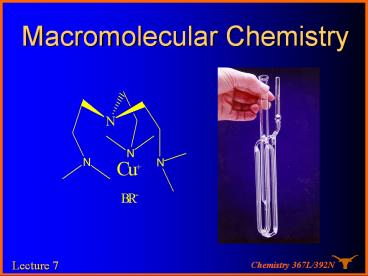OC 2/e 12 - PowerPoint PPT Presentation
Title:
OC 2/e 12
Description:
Lecture 7 Decomposition of Thermal Initiator The chain growth system The relationship between DP and conversion With termination reactions TEMPO Controlled ... – PowerPoint PPT presentation
Number of Views:65
Avg rating:3.0/5.0
Title: OC 2/e 12
1
Macromolecular Chemistry
Lecture 7
2
Decomposition of Thermal Initiator
I ? 2 R
Efficiency factor ( f )
di-tert-butylperoxide AIBN di-tert-butylperoxala
te f 0.65 f 0.75 f0.95
3
Kinetics of free radical polymerization
? Steady state assumption
Ri Rt
- dM
2
2
M
k
I
fk
2
So
M
t
d
What is the Propagation rate ( Rp )
-dM
kpM
Rp
dt
4
Kinetics of free radical polymerization
Average kinetic chain length ( ? )
R
R
p
p
?
R
R
t
i
M
k
M
k
M
M
p
p
?
2
K
p
2
(
2
2
I
k
fk
M
k
M
k
d
t
t
t
?
Disproportionation Combination
DP
2?
DP
5
The chain growth system
- The relationship between DP and conversion
- With termination reactions
6
TEMPO Controlled Polymerization
(2,2,6,6-tetramethylpiperidinyl-1-oxy)
TEMPO
(2,2,6,6-tetramethylpiperidinyl-1-oxy)
TEMPO
7
Radical Chain Growth
Chain polymerization with termination
- Life time of polymer radical chain is about 1
second - Initiator slowly decomposes throughout
polymerization time - Steady State approximation
- rate of initiation rate of termination
- Therefore, propagating radical remains
constant
Chain polymerization without termination
e.g. nitroxide-mediated radical polymerization
Initiator decomposes quickly (high temp) polymer
chains have long life times
8
Controlled Free Radical Polymerization
9
Library of alkoxyaminesevaluated as initiators
for the living free radical polymerization of
styrene and n-butyl acrylate.
10
Acrylates???
TEMPO
11
Published Example of Block Copolymer Formation
Reversible trapping prevents irreversible
termination
A living poly(styrene) block heated in the
presence of methyl acrylate to give diblock D
12
Control of polymer Architecture
13
(No Transcript)
14
Step growth system
- The relationship between Mwt and conversion
15
The chain growth system
- The relationship between Mwt and conversion
- With termination reactions
16
The chain growth system
- The relationship between Mwt and conversion
- With no termination reactions
17
Other Controlled/Living Radical Polymerizations
Nitroxide mediated stable free radicals e.g.
TEMPO Atom Transfer Polymerisation
Cu(I)Br/Ligand RAFT thioesters/xanthates
18
Atom Transfer Radical Polymerization - ATRP
K. Matyjaszewski Macromolecules 1997, 30, p7697
7042 7034 7348 8161 7692 6507, 6513, 6398
JACS 1997, 119, p674 V Percec Macromolecules
1997, 30, p6705, 8526 M Sawamoto Macromolecules
1997, 30, p2244, 2249 Teyssie Macromolecules
1997, 30, p7631, Haddleton Macromolecules 1997,
30, p2190
19
ATRP
ATRP works on Acrylates !!
Macromolecules, 30 (25), 7697 -7700, 1997.
20
Living Free-Radical Polymerization by
Reversible Addition-Fragmentation Chain Transfer
The RAFT Process
Magic Reagent
Macromolecules, 31 (16), 5559 -5562, 1998
21
Radical addition to Dithionate esters
22
RAFT Polymerisation
23
RAFT works!!
Molecular weight distributions for
poly(styrene-co-acrylonitrile) polymerized by
heating styrene and acrylonitrile (6238 mole
ratio) at 100 C in the presence of cumyl
dithiobenzoate
24
CRP - Issues
- Colored Products
- Strange Chain ends
- Metal Contamination
- The role of Cu in ATRP
- Sociology and psychology
FRONTIERS IN POLYMER CHEMISTRYVIRGIL PERCEC,
GUEST EDITOR
Chemical Reviews Volume 101, Issue 12 (December
12, 2001)
25
Measuring Molecular Weight
- Membrane Osmometry ? Alfredo
- Vapor Phase Osmometry ? Linda
- Viscometry
- Gel Permeation Chromatography
- Size exclusion Chromatography
- Light Scattering
- MALDI
- Others
- End group analysis ? , etc.
26
Definition of viscosity
- For normal (Newtonian) flow behaviour
- t (F/A) h . (dv/dy)
viscosity
shear rate
units (dyne/cm2)/sec-1
dyne.sec.cm-2. . POISE
(P)
shear stress
h t/(dv/dy)
At 20.0oC, h(water) 0.01P 1.0 Centipoise
27
Viscosity of Polymer solutions
A dissolved macromolecule will INCREASE the
viscosity of a solution because it disrupts the
streamlines of the flow
28
Ubbelohde Viscometer
29
Types of Viscometers
- U-tube (Ostwald or Ubbelohde)
- Cone Plate (Couette)
30
Relative viscosity hr
We define the relative viscosity hr as the ratio
of the viscosity of the solution containing the
macromolecule, h, to that of the pure solvent in
the absence of macromolecule, ho hr h/ho
units? For a U-tube viscometer, hr
(t/to). (r/ro)
31
Reduced viscosity
The relative viscosity depends (at a given temp.)
on the concentration of macromolecules, the shape
of the macromolecule the volume it occupies.
We can infer things about the shape and volume of
the macromolecule if we eliminate the
concentration contribution. The first step is to
define the reduced viscosity hred (hr 1)/c
Where C is the concentration in
gm/ml
32
The Intrinsic Viscosity h
To eliminate non-ideality effects deriving from
exclusion volume, backflow and charge effects,
etc we by analogy with osmotic pressure, measure
hred at a series of concentrations and
extrapolate to zero concentration
h Limc?0 (hred)
units h ?
33
Molecular Weight from h
Mark-Houwink-Kuhn-Sakurada equation h
K Ma
a 0
a 1.8
a 0.5-0.8
34
Representative Viscosity-Molecular Weight
Constantsa
aValue taken from Ref. 4e. bSee text for
explanation of these constants. cAtactic d?
temperature. Weight average. fNumber
average. gN,N-dimethylformamide.































